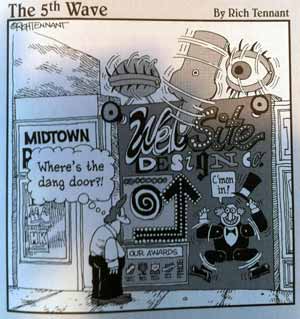In the beginning
Some web designers hold on to the antiquated idea that information on your website should all be above the fold. This design rule comes from the idea of printed newspapers that are displayed and sold flat. What you see in the display of a newspaper is everything above the fold. What is above the fold is what is supposed to get your attention so you will purchase the newspaper to read the story.
In the early days of the web, back in the late 90′s, web designers took the print rules and applied them online. Of course, then screens were small and people were not very likely to scroll beyond what was on the screen. Scrolling was even less likely at that time when AOL chopped everything into 800 X 600 displays and then required you to click to the next page to get to more information rather than scroll down.
People have changed the way they view
Things have changed a great deal since those early days of the web. Now, we aren’t only viewing sites on our computer, we are also viewing them on mobile devices and tablets. Screen sizes and screen resolution can vary greatly between different machines and devices, so the above the fold rule just doesn’t make sense anymore. Also, with the popularity of social media sites like Facebook and Twitter, and the explosive growth of blogs and blog readers, most people are very comfortable now with scrolling for more information.
Studies dispel the myth
There have been many studies that have shown that people do indeed scroll which have debunked the myth of the above the fold design. Most notably was a study by CX Partners that was conducted over 6 years where they used eye tracking, user data and click data in over 800 sessions to test the validity of the fold being a barrier. Milissa Tarquini, Director of User Interface Design and Information Architecture at AOL, also took a look at above the fold data which she outlines in her article Blasting the Myth of the Fold. She tells us:
There is an astonishing amount of disbelief that the users of web pages have learned to scroll and that they do so regularly. Holding on to this disbelief – this myth that users won’t scroll to see anything below the fold – is doing everyone a great disservice, most of all our users.
It’s a new world
Unless you are using a separate style for mobile devices (which is recommended), you will find that the above the above the fold design is not particularly mobile friendly. In my own research of looking at above the fold designs on my iPhone, I found that the display crammed all of the information in the top half of the screen while the bottom half of the screen was blank. It was not a good use of the limited amount of space that is available on a mobile device. I have not yet looked at any of these sites on a tablet, but would be interested to see how they are displayed there.
Does the fold ever matter?
The fold is kind of an ambiguous term at this point. As we have already mentioned, the fold on different devices and with different resolutions is hard to even define. However, some consideration should definitely be given as to what is at the top of the screen. What is “above the fold” should be what is most important. It should be the answer to why someone is visiting your site.
People land on your site for a reason. You need to give them a reason to stay. That has always been the case whether you believed people scrolled or not. Include compelling content and calls to action. Always keep the needs of your customer as your most important consideration.




 The answer is . . . it depends. It depends upon the type of business it is. If it is the website of a graphic artist, it may be important to you that she has the same sense of color as you. If you are looking for a wedding planner, you may look for a wedding planner’s website that projects the type of feeling you want at your wedding.
The answer is . . . it depends. It depends upon the type of business it is. If it is the website of a graphic artist, it may be important to you that she has the same sense of color as you. If you are looking for a wedding planner, you may look for a wedding planner’s website that projects the type of feeling you want at your wedding. Is your website a traditional advertisement for your business or something more?
Is your website a traditional advertisement for your business or something more?
 Growing businesses are always looking to acquire new assets and to protect those assets. Often, businesses don’t realize the value of their website as an asset for their business. Many times, especially in small businesses, a website is something that is added as an afterthought and not seen as a valuable part of a marketing strategy.
Growing businesses are always looking to acquire new assets and to protect those assets. Often, businesses don’t realize the value of their website as an asset for their business. Many times, especially in small businesses, a website is something that is added as an afterthought and not seen as a valuable part of a marketing strategy.
 You may have noticed, many grocery stores have similar layouts. The dairy and meat departments tend to be at the back of the store. You have to walk past a lot of other enticing items to get to those mainstay departments. Staple items like salt and flour are usually on lower shelves. Specialty spice blends are placed at eye level. That makes it easier for those items to capture your attention and hopefully go in your cart.
You may have noticed, many grocery stores have similar layouts. The dairy and meat departments tend to be at the back of the store. You have to walk past a lot of other enticing items to get to those mainstay departments. Staple items like salt and flour are usually on lower shelves. Specialty spice blends are placed at eye level. That makes it easier for those items to capture your attention and hopefully go in your cart. We have talked a lot on this blog about the importance of
We have talked a lot on this blog about the importance of